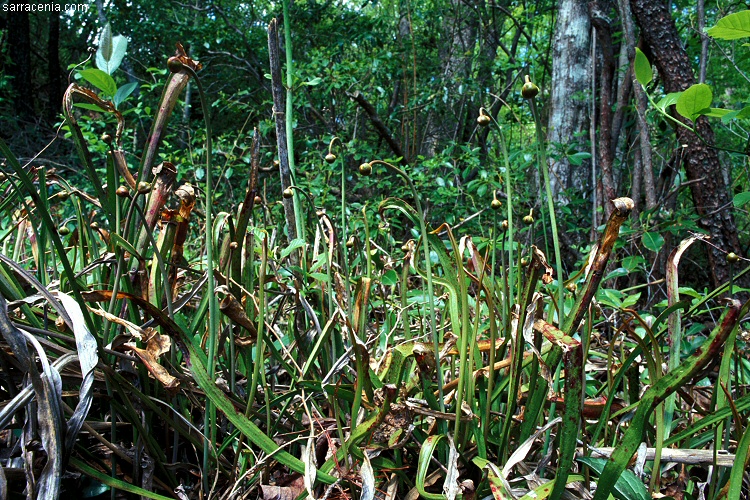
Developing flowers
Again, as it was early in the year these plants were still looking pretty ratty, but even so you can see a nice
set of flowers in early development.
I walked the perimeter of the entire bald
(very carefully, for the health of both myself and the fragile cataract bog community!) to try to understand where the plants
occurred. They were located on only one edge of the bald, and in this short stretch they were densely packed. Apparently,
none of the rest of the habitat was suitable. (At least for now.)
So what happens to all the seeds produced each year? I
guess they just wash away downstream. I considered scrambling downstream
to explore for more populations, but
the bouldery, slippery streambed was extremely rough going, with dense rhododendrons and easily damaged soft-soil slopes.
I nixed that idea
(at least for now). As far as I could see, the downstream habitat was too shaded for Sarracenia, but I bet a nicely
hydrophobic Sarracenia seed could travel a long distance during the six months it remains dormant before
germinating.
Chunks of rhizome, detached by heavier rains, might also survive long enough to float to some downstream location. I thought
about the previously visited site, where there was allegedly a cataract population of Sarracenia upstream of the pond where I
saw them. On timescales of thousands of years, I could imagine Sarracenia moving around the landscape, exploring suitable
habitat locations as they open.
Of course, such was the case pre-industrial revolution. Now the hydrology is changing and global climate change is increasing.
Invasive species and other threats are changing the rules of succession and survival for the native species.
I wonder if these sites are shrinking--mountain bogs are very
sensitive and easily damaged.
Here is a closer view of some more advanced plants. At this point, let me
reveal a secret. In most of these photographs I was not as close to the plants as you might think.
The habitat was both too fragile and too treacherous to allow me to venture as close
to the plants as I would have liked.
The photograph above, for example, was taken using a 200mm lens, about 10 meters from the plants! When in the field, remember
to err on the side of protecting the plants. Don't damage fragile habitats because you are trying to get a closer
view or a better photograph!